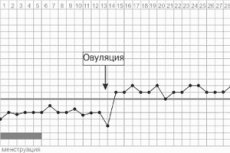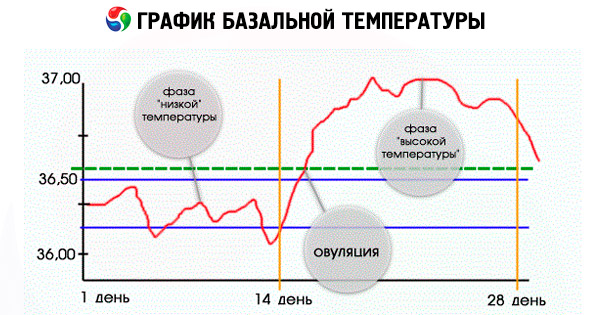Medical expert of the article
New publications
Basal temperature immediately after ovulation
Last reviewed: 08.07.2025

All iLive content is medically reviewed or fact checked to ensure as much factual accuracy as possible.
We have strict sourcing guidelines and only link to reputable media sites, academic research institutions and, whenever possible, medically peer reviewed studies. Note that the numbers in parentheses ([1], [2], etc.) are clickable links to these studies.
If you feel that any of our content is inaccurate, out-of-date, or otherwise questionable, please select it and press Ctrl + Enter.

Basal temperature after ovulation can be a very informative indicator if you have a regular cycle and you measure it correctly. At first glance, it seems useless to measure basal temperature, but in fact, this indicator will allow you to plan your life. To know how to do this, you need to understand the concept of the relationship between basal temperature and the cycle.
What is basal temperature and how to measure it?
Your basal body temperature is your temperature when you are completely calm and resting. Your basal body temperature changes depending on a number of factors, including your hormones. When ovulation occurs, the hormone progesterone causes your temperature to rise. It stays higher during the two-week wait. Then, just before your period starts, the hormone progesterone drops. And unless you are pregnant, your temperature will drop, because in that case, your temperatures will stay higher because progesterone will stay high.
Read also: What is the basal temperature before menstruation?
Thus, the level of hormones determines the temperature fluctuation. It is this fluctuation that depends on the different hormonal phases that suggest changes associated with ovulation. The actual temperatures are less important than the designation of the picture showing two temperature levels. Before ovulation occurs, the initial body temperature fluctuates between 36.1 and 36.3 degrees. This is due to the presence of estrogen, which slows the rate of temperature increase.
After the egg is released, the temperature rises to a new, higher level, usually fluctuating between 36.4 and 36.6 C. Over the next 24 hours, the temperature usually rises by at least 0.2 degrees, and then continues to rise slightly. This rise in temperature is caused by progesterone released from the follicle after ovulation. After a few days, it will become apparent that it is in a new, higher range. The temperature itself will continue to rise and fall from day to day, but will remain in the higher range.
The actual temperatures are less important than the designation of the pattern showing two temperature levels. If you are not pregnant, then your temperature will rise for 10 to 16 days until the corpus luteum regresses. At this time, progesterone levels drop sharply and you get your period. Your temperature usually drops at this time as well, although it is not uncommon to have erratic or high temperatures during your period.
How to measure temperature? To build a chart of your basal temperature, which will allow you to judge your cycle, you must track your temperature and cycle for at least a month. It is better to start from the first day and follow the measurements daily, writing them down. On the first day of the next period, start a new chart and the recording process again and again. Continue to collect the chart for at least 3 cycles, because only then will you be able to know exactly when to expect ovulation.
Take your first temperature in the morning before you get out of bed or even talk - leave your thermometer by your bed within easy reach so you don't have to move around much to get it. If you use a glass thermometer, make sure you shake it before you go to bed.
Try to measure your temperature at the same time each day as much as possible - set an alarm if you need to. Measuring half an hour either side of the average measurement time is the best way to control this, as your temp and temperature can vary depending on the time of day (for example, if you usually measure your temperature at 6am, it's okay to measure it between 5:30-6:30, but the closer to 6am the better). Normal variation is up to 0.2 degrees per hour - lower if you measure your temperature early, higher if you measure late.
It is best to take measurements after at least 5 hours of sleep.
You can measure your temperature on the mucous membranes, vaginally or rectally - just use the same method throughout your cycle.
You should try to place the thermometer in the same way every day (same location, same depth vaginally and rectally).
Plot your temperature on a chart every day, but refrain from predicting too much until your cycle is complete. After three months of charting, you will have basal body temperature data that accurately displays ovulation and all processes to monitor your cycle and sex life.
Changes in basal temperature during ovulation
The level of rise or fall in temperature cannot predict ovulation – and that’s the key. But you can know when it has already happened and a few days after it has happened, thanks to a chart. So you can’t judge whether you had sex on the “right days” until ovulation occurs. You are more likely to get pregnant if you had sex in the two days leading up to ovulation.

What is your basal body temperature after the day of ovulation? The norm for this varies, but after ovulation there must be a temperature shift of at least 0.4 degrees over a 48-hour period to indicate ovulation. This shift must be higher than the highest temperatures of the previous six days, allowing one temperature to be discarded as inaccurate (accident, illness). Perhaps the best way to explain this is to show an example.
For example, if after ovulation the basal temperature is 37-37.4, this is a sign that ovulation has occurred. But if the basal temperature after expected ovulation is 36.6-36.9, then it can be expected that there was no ovulation or the measurements are inaccurate.
Once you see a temperature shift for at least three days or at the end of your cycle, you can identify the midpoint between the follicular phase and luteal phase temperatures, which is when you ovulate.
So you should see an increase of 0.4 – 0.5 degrees higher than the temperature throughout your cycle. If fertilization has occurred, then progesterone does not decrease and keeps the temperature at a stable level. The basal temperature after ovulation during pregnancy is maintained. This leads to the fact that on your chart there is a period of rising values, which has not fallen for a long time. This may well correspond to pregnancy.
How long does your basal body temperature last after ovulation? Around day 14, your temperature will increase above average. This increase will last for 10-16 days. Your temperature will usually drop around day 14. If this does not happen, then fertilization has probably occurred.
For most women, their luteal phase does not vary more than a day or two from month to month, even if the length of their menstrual cycle varies. For example, a woman's cycle may vary between 30 and 35 days, but the luteal phase may be 12 or 13 days. If your basal body temperature does not rise after ovulation, you should consider that you are not ovulating. If you are not ovulating, you cannot get pregnant. If you are ovulating irregularly, this may indicate a possible risk of infertility. The lack of ovulation is called anovulation and is a common cause of female infertility. Most women with anovulation can take medications that will induce ovulation and help them get pregnant.
Read also: Low basal temperature: in the second phase of the cycle, after ovulation, during pregnancy
Sometimes it happens that after ovulation the basal temperature drops – this is a sign of a violation of the level of hormone regulation. Perhaps, if you cannot get pregnant, then you have a progesterone deficiency.
A high basal temperature after ovulation is a sign of ovulation itself, which can be an important indicator for women planning a pregnancy. But before focusing on regulating your cycle by tracking your basal temperature, you need to build your own chart for at least three months of observation.


 [
[